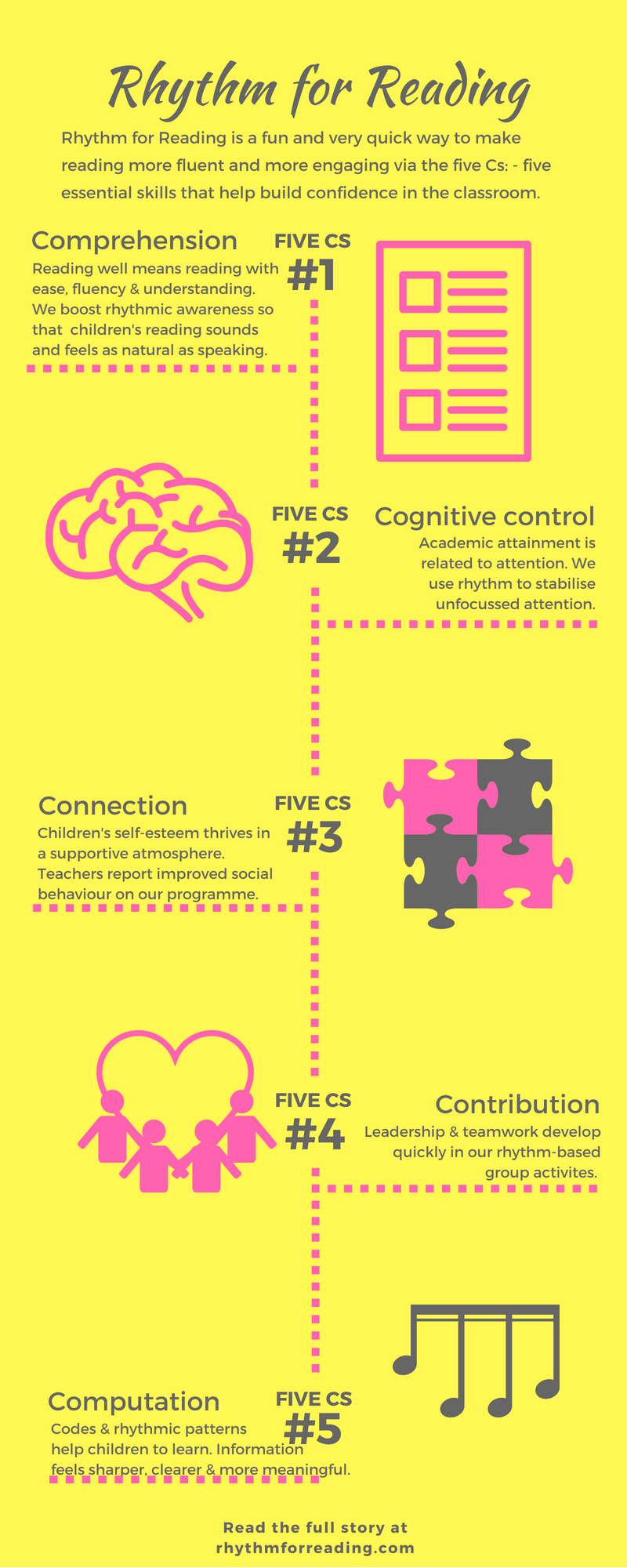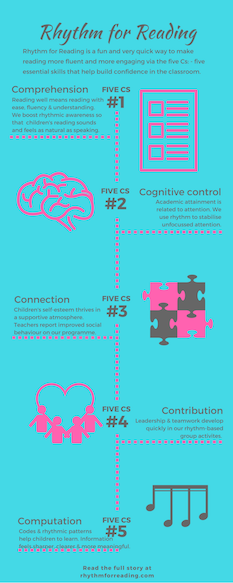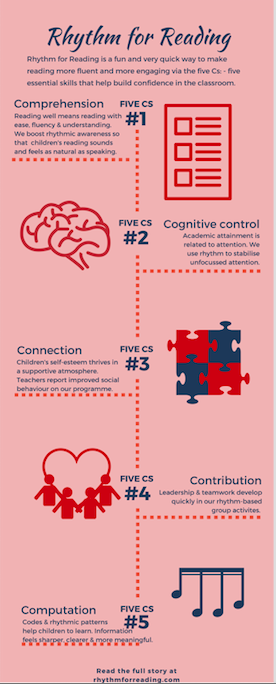The Rhythm for Reading blog
Rhythm and Connection 3 / 5
2 September 2018
The new school year is about to start and for the young people transferring to secondary school, September will bring new friendships, new relationships with teachers as well as new journeys to and from school. A few years ago I worked on a fascinating research project about secondary school transfer across England, interviewing 24 young people at four points in time. The young adolescents left their primary schools full of positivity and high expectations, anticipating with relish many new friendships and exciting opportunities.
I heard about novelty, new ideas, a fresh perspective, a change of environment, hope, excitement and fulfilment. Moving beyond the limits of primary school was a very strong theme - though the young people stressed the importance of maintaining strong connections with their ‘old’ friends, meeting them at weekends to enjoy ‘messing about’ (dancing and singing to their favourite songs), whereas socialising with their ‘new’ friends after school involved talking and listening to one another’s music. Isn’t this contrast interesting? Music appears incredibly important for building deeper social connections.
Looking at everyday social behaviour, music is woven into our lives at a personal level as well as at the level of musical experiences in the wider community. For example, personal musical preferences are important at an individual level, such as when singing and dancing with infants and children, sustaining attention on tasks and work, forming romantic relationships and even in resolving problems with health. However, music is also used more publicly for celebrations in families, social groups, workplaces and communities.
Broadly speaking, it seems that music that we are exposed to via mass media may help to relax vigilance, inhibition, scepticism and caution. Film makers for example regard music as essential in helping their audience to suspend their disbelief, to relax their critical judgement, to be more easily persuaded by the special effects as well as being captivated by the fiction, the drama and characters. What might explain this?
Humans are mammals and to some extent tend to revert to socially instinctive behaviour when socially uninhibited. Studies of other mammals such as rats and mice have shown that social signals related to mating, nurturing or protecting young are processed in the mid-brain.Remarkably, tiny mice pups produce ultra-sonic squeaks when separated from the rest of the litter and scientists have shown that only mother mice actually hear these high frequencies (Liu et al, 2006; Liu et al., 2007). Since, many mammal species commit infanticide, this specialised form of social signal is highly advantageous, ensuring that the vulnerable pups have a greater chance of survival.
Mythical tales of abandonment, involving fear of the jaws of death followed by the joy of reunion are familiar themes in stories from all around the world. Sound is a primal medium of connection and communication via mid brain processes that are rapid, subjective, subtle and subconscious. Similarly, the telling of stories, the recitation of poems and songs are also examples of how auditory signals are woven together to communicate for example fear, distress and joyful reunion, or other emotions. Telling a story involves a particular style of social engagement known as entrainment, drawing people in, encouraging them to lean into the tale using a particular blend of structure and rhythm and emotional processing. The auditory structures allow listeners to suspend their disbelief, to step inside the story with the narrator creating a state of seeming emotional safety. The use of descriptive language to convey the affect (emotional content) of the narrative may help individuals and communities to process disturbing feelings within a structure, a contextual framework of time and space. The structure allows the tale to be retold and remembered for future social gatherings.
In Rhythm for Reading, the entrainment process involves the sharing of motion, affect, the chanting of rhythmic patterns within musical structures. The specially composed musical resources create the time and space for this type of social engagement. Although this is a reading intervention that doesn’t use words, here are some case studies, demonstrating changes in reading after taking part in our rhythm-based group entrainment exercises.
Liu RC, Linden JF, Schreiner CE. 2006. Improved cortical entrainment to infant communication calls in mothers compared with virgin mice. Eur J Neurosci 23:3087–3097.
Liu RC, Schreiner CE. 2007. Auditory cortical detection and discrimination correlates with communicative significance. PLoS Biol 5:e173.
Rhythm and Cognitive Control 2/5
1 June 2018
When a child is able to focus their attention, they are able to learn. When attention is fragmented or fades too quickly, little learning takes place. In this post I will explain why rhythm has a strong role to play in strengthening working memory, self-regulation and cognitive switching. These three aspects of cognitive control influence the way that attention supports learning. A weak working memory is frequently described as an invisible ‘barrier’ to learning and is prevalent in specific learning difficulties such as dyslexia. Working memory is the blackboard of the mind - the mental space upon which mental calculations, tasks, plans or lists can be reordered, manipulated and stored for a short period of time. Children with a weak working memory are able to manipulate and recall a span of only three information units, whereas those with a stronger than average working memory have a span of nine or more information units. However, the ability to manipulate and store information need not be limited by working memory span.
Infants acquire their mother tongue by detecting the rhythmical patterns in the overall stream of speech utterances (Saffran et al., 1996). Sensitivity to rhythm expands working memory by ‘chunking’ the information into rhythmical groups, which is why it is often easier to recite a phone number by clustering the digits together in threes or fours. This chunking strategy probably extends way back through thousands of generations. Preliterate societies have transmitted and conserved cultural practices through singing and storytelling, but also via rhythmical chanting and reciting of verses.
Now that we are a predominantly literate society, we are a little out of touch with the ancient tradition of rhythmically chanting of large amounts of information. However, memory experts show that it is possible to extend the natural span of working memory substantially and to recall information reliably by using chunking strategies (Mathy et al., 2016). For example, Rajan Mahadevan memorised at least 30,000 digits of pi by chunking the digits into groups of ten, he practised recalling the digits and extending the list further day after day (Ericsson & Moxley, 2014).
In classrooms, some children struggle to concentrate. Their attention is scattered rather than focused, or may fade before they can engage with learning. Failed attempts to focus are frustrating for them and often spark a negative spiral, which leads to low self-esteem. Mindfulness training has shown that focussing on the rhythm of the breath is an effective way to overcome distracting, negative thoughts (Siegel, 2007). However, teachers of children who have completed the Rhythm for Reading programme comment on visible improvements in concentration, which indicates that a ten-minute burst of rhythmic activity per week reinforces focussed attention and strengthens cognitive control.
Children lacking cognitive control are usually impulsive and struggle with interpersonal skills. They are low in self-regulation, a form of cognitive control that involves willpower and the perseverance to resist distractions and inhibit impulses, particularly while working towards a particular goal or target (Zimmerman, 2000) and usually emerges in very young children prior to starting school (Rothbart et al., 1992). The rhythm-based activities of the Rhythm for Reading programme, which were first designed for a group of children with little or no inhibition or self-regulation, are immensely effective in cultivating self-awareness and self-regulation in line with increased sensitivity to rhythm. There is also a deeper engagement with reading towards the middle of the programme. Being better able to detect the rhythmic ebb and flow in the text, the focus of attention narrows during the process of reading, effectively blocking out distractions. Self-regulation becomes a form of metacognition as the children monitor their awareness of their reading experience. Their information processing becomes sharper, enabling a natural ease to emerge in both self-awareness and cognitive control of the reading process (Long, 2014).
While self-regulation filters out distractions during reading, cognitive switching builds flexibility into reading behaviour. An obvious example would be that if the reader detected an error, they would need to be sufficiently flexible to stop the flow of information, backtrack in the text and then restart without losing the overall thread of the passage. A less obvious example might involve the reader in alternating their awareness between different points of view in a dialogue. A degree of cognitive switching would be involved until these points of view had been securely assimilated and integrated into the overall comprehension of the text. Sensitivity to rhythm assists flexibility during reading by supporting the overall security, stability and assimilation of the text, however demanding it may be.
Cognitive control supports focussed attention and improved sensitivity to rhythm contributes to cognitive control in several ways: (i) organisation of information in working memory, (ii) inhibition of distracting thoughts and (iii) security during cognitive switching. Taken together, these functions support focussed attention, the development of skilled reading and independence as a learner, all of which are required to mitigate the effects of disadvantage (Heckman, 2006).
A newly published paper on a randomised controlled trial shows the statistically significant effect of rhythmic training on disadvantaged children’s reading comprehension. Read more here.
Ericsson, K. A., & Moxley, J. H. (2014). Experts’ superior memory: From accumulation of chunks to building memory skills that mediate improved performance and learning. In T. J. Perfect & D. S. Lindsay (Eds.), SAGE handbook of applied memory (pp. 404-420). London, UK: Sage Publishing
Heckman, J.J. (2006) Skill formation and economics of investing in disadvantaged children, Science, 312, 1900-1902.
Long, M (2014) “‘I can read further and there’s more meaning while I read’: An exploratory study investigating the impact of a rhythm-based music intervention on children’s reading.” Research Studies in Music Education 36.1: 107-124.
Mathy, Fabien, et al. (2016)Developmental abilities to form chunks in immediate memory and its non-relationship to span development.” Frontiers in psychology 7: 201.
Rothbart, Mary K., Hasan Ziaie, and Cherie G. O’Boyle. (1992) Self‐regulation and emotion in infancy.New directions for child and adolescent development 55: 7-23.
Saffran, Jenny R., Richard N. Aslin, and Elissa L. Newport. (1996) Statistical learning by 8-month-old infants.” Science 274.5294: 1926-1928.
Siegel, D. (2007) The Mindful Brain New York: Norton
Zimmerman, B.J. (2000). Attaining self-regulation: A social cognitive perspective. In M. Boekaerts, P.R. Pintrich, & M. Zeidner (Eds) Handbook of self regulation (pp. 13-39). San Diego: Academic Press
Rhythm and Reading Comprehension 1/5
29 April 2018
‘To be understood - as to understand’ from the prayer of St Francis captures a profound truth: we are at our happiest when we feel truly understood by others. This feeling of mutual understanding strengthens communities and generates an aura of certainty at the core of each individual’s character. The ability to understand exists in all of us, but can easily be obscured by doubt, worry or fear. Removing worries, doubts and fears leads to clarity –as Johnny Nash put it, “I can see clearly now the rain has gone…”. The same principle applies to reading comprehension. The songlike qualities of speech (i.e. prosody) come to life in children’s voices when they are able to read with ease, fluency and understanding.
In the Simple View of Reading, reading comprehension is described as the ‘product of’ skilled decoding and linguistic comprehension (Gough & Tumner, 1986). The recent focus on oracy (for example Barton, 2018) highlights a focus in some schools on linguistic comprehension. According to researchers, the proportion of children beginning school with speech, language and communication needs is estimated at between 7 and 20 per cent (McKean, 2017) and unfortunately, communication issues carry a risk of low self-esteem and problems with self-confidence (Dockerall et al., 2017).
In the Gough & Tunmer model, the term ‘product of’ seems a little vague. I like to think that ‘product of’ refers to the flexible quality found in skilled reading as well as the dynamic integration of natural language with the alphabetic code. At first, beginning readers struggle to accommodate words and sentences of a variety of shapes and lengths, but as they become more skilled, they ease into a state of flexible, responsive reading, which leads to being able to read sentences whilst processing meaning at the same time. What is even more remarkable about this process is that reading with this wonderful flexibility takes place within distinct time constraints.
The time constraints are a kind of rhythmic signature for language comprehension as well as music and are biologically determined (Long, 2006). Each and every line of a song, poem or musical phrase typically lasts for 3-5 seconds. This brief ‘window’ is our subjective sense of the present moment (Gerstner & Fazio, 1995). In a song, a poem or a musical phrase, this moment is packed with messages and meanings – relating information about feeling, being or doing. The rhythm of reading in any language is very flexible indeed, but it is underpinned by this constant ebb and flow of units of meaning every 3-5 seconds. Becoming aligned with this natural flow of meaning helps children to read words, phrases and sentences with ease, fluency and understanding and also to anticipate words and phrases prior to reading them.
The importance of this rhythmic ebb and flow of meaning cannot be overstated and is a core part of the Rhythm for Reading programme. The programme uses music rather than words to develop rhythmic sensitivity, so it is suitable for children and young people who need a sharp ‘boost’ in reading comprehension, language and communication skills, phonological awareness or cognitive control, whether attending mainstream or special schools.
Barton, G “Teachers should encourage pupils to speak up – and should remember to do so themselves TES News https://www.tes.com/news/teachers-should-encourage-students-speak-and-remember-do-so-themselves Retrieved on 29.4.2018
Dockrell, Julie Elizabeth, et al. “Children with Speech Language and Communication Needs in England: Challenges for Practice.” Frontiers in Education. Vol. 2. Frontiers, 2017.
Gerstner, Geoffrey E., and Victoria A. Fazio. “Evidence of a universal perceptual unit in mammals.” Ethology 101.2 (1995): 89-100.
Gough, Philip B., and William E. Tunmer. “Decoding, reading, and reading disability.” Remedial and special education 7.1 (1986): 6-10.
Long, M. “Stamping, clapping and chanting: An ancient learning pathway?” Educate Journal, 3, 1, (2006) 11-25
McKean, Cristina, et al. “Language Outcomes at 7 Years: Early Predictors and Co-Occurring Difficulties.” Pediatrics(2017): e20161684.
Catch-Up and Catch-22
14 April 2018
Academic achievement relates strongly and reciprocally to academic self-concept, for example in English and Maths (Schunk & Pajares, 2009) and also reading (Chapman & Tumner, 1995); moreover the importance of motivation increases as perceptions of reading difficulty increase (Klauda et al., 2015). So reading catch-up can also feel as if it’s a catch-22 situation. To resolve this issue, Hattie (2008) recommended that teachers teach self-regulating and self control strategies to students with a weak academic self-concept: ‘address non-supportive self-strategies before attempting to enhance achievement directly’ (Hattie, 2008; p.47).
Peeling back the layers on the self-concept literature, various models and analogies are available (Schunk, 2012). Hattie’s highly effective analogy of a rope captures rather vividly the idea of the congruence of the core self-concept as well as the multidimensionality of intertwining fibres and strands that are accumulated via everyday experiences (2008, p.46). The rope image supports the idea that a particular strand applies to maths, whereas a completely different strand applies to reading and another one for playing football and so on.
The relationship between self-concept and academic achievement is reciprocal (Hattie, 2008) and also specific to each domain (Schunk,2012). Therefore, strengthening self-concept for reading supports achievement in reading, while strengthening self-concept for maths supports maths skills. It is very difficult to strengthen low self-concept in a specific domain before addressing achievement in that area, unless introducing a completely new approach. It is important that the new approach supports self-strategies as well as directly building strength in domain-relevant skills. The Rhythm for Reading programme meets both of these requirements.
Rhythm for Reading works as a catalyst for confidence and reading skills and therefore lifts a negative reciprocal relationship (catch-22 situation) into a positive cycle of confidence and progression. This programme is effective as a reading catch-up intervention because it offers a fresh and dynamic approach, which perfectly complements to traditional methods. Instead of reading letters and words, pupils read simplified musical notation for ten minutes per week. Consequently, they are practising skills in decoding, reading from left-to-right, chunking small units into larger units, maintaining focus and learning, as well as developing confidence, self-regulation and metacognitive strategies all the while.
The musical materials used in the Rhythm for Reading programme have been specially written to be age-appropriate and to secure pupils’ attention, making the effortful part of reading much easier than usual. In fact, throughout the programme, the cognitive load for reading simple music notation is far lighter than for reading printed language, enabling an experience of sustained fluency and deeper engagement to be the main priority. As these case-studies show, this highly-structured approach has had huge successes for low and middle attaining pupils, who were able to read with far greater ease, fluency, confidence and understanding after only 100 minutes (ten minutes per week for ten weeks).
Chapman, J. W., & Tunmer, W. E. (1995). Development of young children’s reading self-concepts: An examination of emerging subcomponents and their relationship with reading achievement. Journal of Educational Psychology, 87, 154–167.
Hattie, J. (1992). Self-concept. Hillsdale, NJ: Erlbaum.
Hattie, John.(2008) Visible Learning: A Synthesis of Over 800 Meta-Analyses Relating to Achievement. Routledge.
Klauda, Susan Lutz, and John T. Guthrie. “Comparing relations of motivation, engagement, and achievement among struggling and advanced adolescent readers.” Reading and writing 28.2 (2015): 239-269.
Pintrich, P.R. and Schunk, D.H. (2002). Motivation in education: Theory research and applications (2nd edition) Upper Saddle River, NJ: Merrill.
Rogers, C.R. (1959). A theory of therapy, personality, inter-relationships as developed in the client-centered-framework. In S. Kock (Ed) Psychology: A study of a science, Vol.3, pp.184-256 New York, McGraw-Hill.
Schunk, D. H. and Pajares, F. (2009). Self-efficacy theory. In K. r. Wentzel & A. Wigfield (Eds.), Handbook of motivation at school (pp. 35-53). New York:Routledge.
Schunk, D.H. (2012) Learning theories: An educational perspective, 6th edition, First published 1991 Boston: Allyn & Bacon, Pearson Education Inc.
Statistically significant impact after only 100 minutes
1 March 2018People are usually intrigued when I explain that this reading programme requires only 100 minutes from start to finish. In fact, pupils do not necessarily need 100 minutes to accomplish the goals of the Rhythm for Reading programme. Often improved engagement, comprehension, ease, fluency and joy of reading can be achieved after one hour spread across six weeks. A six week programme works well for the majority of children but for some who unfortunately do not attend school consistently, it would be far too easy for them to fall behind. By simply increasing the total length of the Rhythm for Reading programme from 60 to 100 minutes, all the children have enough time to develop their rhythmic awareness and experience the benefits in their reading. When 100 minutes are spread across ten weekly sessions, the programme slots neatly into a school term and this is convenient for everyone.
I am often asked how it’s possible for pupils to make real progress in only ten minutes per week and how certain can we be that the impact is attributable to Rhythm for Reading? These are excellent questions. First of all, pupils are reading everyday in the classroom, so they have ample opportunity to apply the rhythm-based approaches that they learn in the weekly ten-minute sessions to every task that involves reading during the school day. Each ten-minute session acts as a powerful catalyst, aligning decoding skills with the natural language processing abilities of the pupils. As the approach is rhythm-based instead of word-based, pupils with specific learning difficulties such as dyslexia or English as an Additional Language (EAL) benefit hugely from the opportunity to improve their reading without using words. It’s an opportunity to lighten the cognitive load, but to intensify precision and finesse. Secondly, I made sure that Rhythm for Reading was among the first intervention programmes to be evaluated as part of the EEF initiative. In this trial, I chose not to exclude any pupils. This meant that some students that took part were unable to access the reading tests because they could not decode text at all. The randomised controlled trial showed scientifically that improved reading scores were attributable to participation in the Rhythm for Reading programme, even though it took only 100 minutes to complete.
Rhythm, punctuation and meaning
1 February 2018The comma, according to Lynn Truss, clarifies the grammatical structure of a sentence and points to literary qualities such as rhythm, pitch, direction, tone and pace.

Truss says that careful use of the comma announces ‘an ear for sense and rhythm, confidence in your style and proper respect for your reader’ (p.70). The title refers to a well-known joke, which plays on the ambiguity of ‘shoots’ and ‘leaves’ as homonyms. To the ear and eye these words appear the same, but in different contexts their meaning changes. So, in the joke, ‘A panda walks into a bar…’, contexts collide, meanings are superimposed, but the punctuation rescues the reader.
This shows us exactly why reading for meaning is a multi-layered affair. To read the phrase ‘eats, shoots and leaves’ with understanding involves observing the comma as a formal separation of the first two verbs in a series of three, as well as inhibiting a miscommunication of meaning. From a rhythm-based perspective, the comma prevents ‘eats shoots’ from being read as a verb-noun pair. Verb-noun pairs are rapidly processed, high-frequency phrases that provide immediate understanding, such as ‘drives cars’, ‘writes books’, ‘plays games’ and ‘buys drinks’.
Remarking on the similarity between punctuation and musical notation, Truss observed that ‘punctuation herds words together, keeps others apart’ (p.20). Although there are different patterns of emphasis (prominence or stress) in different languages, dialects and indeed regional variations of any given language, what is important is that rhythmical cycles operate at several levels in both language and music. Remarkably, we generate these highly organised, intricate and geometric relationships of time and meaning automatically at a subconscious level of awareness.
At a conscious level, we are more likely to realise how involved or engaged we feel with the meaning of the story or song. Once our attention has been captured, we as an audience can become phase-locked into an experience of heightened awareness, which is effortlessly stored by the memory. In fact, laws, myths, legends and cultural histories have been preserved across generations in this way. This form of group learning via listening feels somewhat mysterious and therefore has often been vaguely described in phrases such as, ‘you could have heard a pin drop,’ ‘having the audience in the palm of your hand’ or ‘sitting on the edge of your seat’. The phase-locked experience is not unique to humans as most living things synchronise with cycles of light intensity. There are also patterns of synchronised sound among insects and synchronised movement in flocks of birds, shoals of fish and herds of cattle.
Through language and music our collective response to sounds (in the air or on the page) naturally predisposes us to become attuned to the recurring cycles of phrases, patterns within phrases and the overarching structures within which phrases are meaningfully grouped. I am not suggesting that we humans are mindless creatures, intrinsically satisfied by the hypnotic pull of recurring rhythmical patterns. No, we are very complex and capable of a vast range of behaviour from incredible subtlety in our rhythmic awareness to tremendous violations of natural rhythmical cycles. In general, our desire for novelty and our urge to create, to surprise, to shock, to satirise and push against outdated institutions, is expressed through rhythm. We have archived our experiences through storytelling and music with the resonance of an authentic human voice. The elasticity of congruent rhythmic structures accommodates newly-combined patterns, reminding us that far from being hypnotised by our own sounds, we are dynamic communicators with the ability to express, create, share and reflect upon our experiences.
Truss, L (2003) ‘Eats, shoots & leaves: The zero tolerance approach to punctuation’ Harper Collins
Inclusive Roots
1 January 2018
The reason that Rhythm for Reading exists at all can be traced right back to a brief moment which was absolutely life changing. This is how it happened… I was working for the very first time with a group of nine year old children who had fallen so far behind their classmates over the years, that their class teacher feared for their future. I found them to be exactly as she had described, constantly misbehaving, very impulsive and unable to concentrate for longer than two seconds. The more important discovery however, was that my teaching techniques, which had until that point always been effective, had failed to engage these children.
Stepping into an inclusive mindset at that moment meant leaving the security of the ‘known’ behind. The first step for me was to acknowledge that I needed to know how to help these children. The second step was to pause for a moment and listen to the children, asking them about the things that they loved to do so that I could teach them more effectively. The third step was to find a way forward from that conversation.
It was obvious that football was hugely important to these children. They spoke about their footballing skills with a confidence that was so sincere, I felt that their commitment to movement could help me to teach them. At that time, the notion of learning through movement and rhythm was extremely unorthodox, but for these children, rhythmic exercises beginning with the feet proved to be extremely beneficial.They were soon better able to concentrate and their behaviour in class became calm and industrious.
Now, some twenty years later, neuroscientists have established the correlation between rhythmic awareness and reading and have shown the importance of movement for learning and memory. Those early steps in particular have been researched, evaluated and formalised into the own online teaching programme Rhythm for Reading.
An inclusive and equitable approach often demands courage and faith, but above all it specifies that teachers put learning first and take the necessary steps to teach children in the way that they can learn. The effects of inclusive teaching and learning have wide ranging benefits. Not only does an inclusive approach transform educational outcomes for all children, but it also reinforces the caring ethos of the school community, as well as deepening knowledge, expanding expertise and empowering teaching.
Through the analysis of data, our educational system has successfully identified inequalities and the influence of these on the future lives of disadvantaged children; but what is urgently needed now is a bold strategic vision with which to implement appropriate approaches that will support individual children, build cohesion within schools and strengthen the communities that they serve.
Conversations, rhythmic awareness and the attainment gap
3 December 2017
In their highly influential study of vocabulary development in the early years, Hart and Risley (1995) showed that parents in professional careers spoke 32 million more words to their children than did parents on welfare, accounting for the vocabulary and language gap at age 3 and the maths gap at age 10 between the children from different home backgrounds.
A critique of the study pointed to a language deficit perspective, social stereotyping and methodological flaws such as selection bias (Dudly-Marling and Lucas, 2009). Some of the points that were raised about language style such as length and tone of an utterance, (comparing longer and more persuasive utterances in middle class US homes with shorter, more direct utterances in ‘welfare’ homes) may indeed highlight cultural differences rather than deficits. However, according to the theory of dynamic attending, shorter utterances, a more direct tone and more abrupt exchanges may influence a child’s attention (Jones et al., 2009), but of course the difference only becomes a deficit if as the child begins pre-school, their attention is too fragile to assimilate the curriculum.
Although the richness of vocabulary was hugely advantageous for children from better-off homes in the Hart and Risley study, researchers have discovered that the opportunities for conversational turns between parents and their children, for example when sharing a book, were even more beneficial than vocabulary development. Conversations have also been identified as a marker for maternal responsiveness, positive emotional exchange and social engagement (Paul & Gilkerson, 2017). From a rhythm-processing perspective, conversations nurture the child’s ability to listen, to engage, to respond and to reciprocate at precise moments in time. Feed-forward systems known to support language acquisition are rhythmically sensitive (Saffran et al., 1996) as are language generating processes such as associative priming (Jones & Estes, 2012).
In pre-school classrooms of societies which have relatively high levels of social inequality, it is unacceptable that an attainment gap between disadvantaged children and their better-off peers still persists twenty years after the publication of the Hart and Risley study. Simply obtaining and critiquing data on attainment and home background is an inadequate response to a persistent problem. As educators we have a responsibility to close the attainment gap and to do so systematically, using a child-centred and holistic approach that is sufficiently bold and rigorous to ensure effective change.
Children who arrive at pre-school with fragile attention and are not yet ready to learn are not difficult to identify. Some children may demonstrate flat attention - generally they are difficult to engage. Some children may have a scattered pattern of fragmented attention - they demonstrate mainly impulsive behaviour. Some children are able to focus their attention, only to find that it fades before they have completed the task. Regardless of whether these children have missed out on the everyday conversations and interactions that systematically nurture cognitive attention during infancy and early childhood, their learning must be supported by stable attention, and according to dynamic attending theory (e.g. Jones et al., 2009), stable attention is supported by rhythmic awareness.
Awareness of rhythm in terms of the conscious perception of words, music, movement and gesture is only the tip of the iceberg, as rhythm is processed to a large extent subconsciously. This subconscious element of rhythmic processing is difficult to teach without specialist training; for example, fragile attention cannot be addressed by simply chanting nursery rhymes or shaking tins of rice in the classroom. However, with a little training and knowledge of the mechanisms that are involved, it is possible to work effectively with both the conscious and subconscious aspects of rhythmic awareness in the classroom, to achieve transformational effects on reading attainment and to do so over a very short period of time (Long, 2014).
Dudley-Marling, C., & Lucas, K. (2009). Pathologizing the Language and Culture of Poor Children. Language Arts, 86(5), 362.
Hart, B., & Risley, T. R. (1995). Meaningful differences in the everyday experience of young American children. Baltimore: Brookes.
Jones MR, Johnston HM, Puente J. Effects of auditory pattern structure on anticipatory and reactive attending. Cognitive psychology. 2006;53:59–96
Jones, L. L. & Estes, Z. (2012). Lexical priming: Associative, semantic, and thematic influences on word recognition. In J. S. Adelman (Ed.), Visual Word Recognition, Volume 2. Hove, UK: Psychology Press.
Long, M. (2014). ‘I can read further and there’s more meaning while I read’: An exploratory study investigating the impact of a rhythm-based music intervention on children’s reading. Research Studies in Music Education, 36(1), 107-124.
Paul, T.D. and Gilkerson, J. (2017). The Talk Gap, In R. Horowitz and S.J. Samuels, The Achievement Gap in Reading: Complex Causes, Persistent Issues, Possible Solutions, Routledge.
Saffran, J.R., Aslin, R.N. & Newport, E.L. Statistical learning by 8-month-old infants. Science 274, 1926–1928 (1996).
